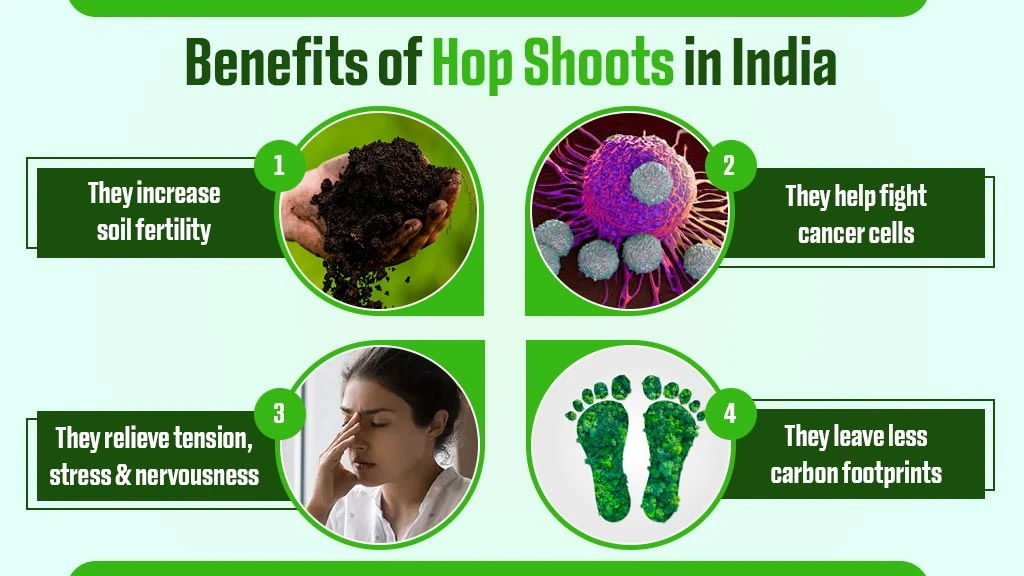
Table of Contents
What are Hop Shoots?
Hop shoots, also known as hop asparagus or hop sprouts, are the young and tender shoots that spring up from the perennial hop plant (Humulus lupulus). This plant is essentially known for its properties and uses in brewing beer, but its shoots have also gained immense popularity for their unique flavor profile and culinary preferences.
The delicate, bright green color hop shoots are highly prized for their earthy, bitter flavor, and are considered a delicacy in the culinary world. Due to their limited availability and distinctive taste, hop shoots are often sought after by gourmet chefs and food enthusiasts worldwide
Cultivating hop shoots requires specific knowledge of agricultural practices and careful attention to the growing conditions. The shoots are typically harvested in early spring when they are at their tender, flavorful best. They can be used in a variety of gourmet dishes, including salads, soups, and stir-fries, adding a distinctive and complex flavor to culinary creations. Hop shoots fruits, flowers, and stems all are useful in making beverages, beer, antibiotics, and aromatic products
Benefits of Hop Shoots

Hop shoots are rich in vitamins, minerals, and antioxidants, making them a nutritious addition to a diet. They are also known for their potential health benefits, which include anti-inflammatory properties, cancer-fighting cells and potential benefits for digestion. In addition to their culinary applications, hop shoots are also valued for their ornamental qualities, as they can be used in floral arrangements and decorations due to their unique appearance and texture.
Overall, the benefits of hop shoots extend beyond their culinary use, as they offer a combination of nutritional value, unique flavor, and potential health benefits
- Soil fertility: by improving soil fertility, the plant contributes to enhancing biodiversity. Hop shoots also lower the flow of hazardous chemicals into the soil and leave less carbon footprints.
- Medicinal benefits: proven to help treat anxiety, insomnia, and other sleep disorders, as well as treating physical ailments like cancer, cholesterol, tuberculosis, etc, hop shoots have high medicinal value.
- Beverages: The profile becomes even better, as the plant’s hop cones can be used as a balancing agent to sweeten beer.
Hop Shoot Cultivation in India
Hop shoot cultivation requires attention to detail, proper care, and knowledge of best practices to achieve successful harvests. It is suggested to consult experienced hop growers and agricultural experts who can provide valuable insights for a successful cultivation venture.
Selection of Site
Choose a site that has well-drained soil, ample sunlight, and ideal climatic conditions for hop cultivation.
Preparation of Soil
Prepare the soil by tilling, adding organic matter, and ensuring proper drainage to create optimal conditions for hop plant growth.
Planting
Plant hop rhizomes or crowns in early spring and ensure proper spacing with support structures for vine growth.
Training and Trellising
Provide support structures such as trellises for the hop vines to climb. Train the vines to grow vertically for better sunlight exposure and air circulation.
Irrigation
Ensure consistent soil moisture for optimal growth. Irrigate regularly, especially when there is dryness in the environment to support healthy hopshoot development.
Fertilization
Apply organic fertilizers or compost to provide essential nutrients to the hop plants. Monitor soil fertility levels at regular intervals for proper plant nutrition.
Pest and Disease Management
Implement integrated pest management techniques to control pests and diseases that can affect hop plants. Monitor for signs of infestation and take appropriate measures to protect the crop.
Harvesting
Harvest hop shoots when they reach the desired size and tenderness, usually in early spring. Handle the shoots carefully to avoid damage and preserve their quality.
Post-Harvest Handling
Clean and store the harvested hop shoots properly to maintain freshness and quality. Consider immediate consumption, sale, or preservation methods like freezing.
Reasons behind Expensive Hop Shoots in India: Market, Prices, and Profits
The hop shoot cultivation is generally expensive in India as it is labor-intensive and requires more effort and time. One yield can approximately produce estimated value of Rs 80,000 to Rs 150,000 depending on market prices and other factors.
Furthermore, there is a specific instance in Bihar, where a farmer cultivated hop shoots and sold them at Rs 1 lakh per kg. These stats indicate a high potential for outstanding profits in hop shoot cultivation in India. However, it's important to note that the actual price and profit can vary based on factors such as market demand, local agricultural practices, and the specific conditions where the crop is being cultivated.
Frequently Asked Questions On Cultivation of Hop Shoot in India
1. Where is hop shoots grown in India?
In India, hops aren't widely grown because they thrive in cooler climates. However, small-scale cultivation is happening in Himachal Pradesh, Jammu and Kashmir, and Uttarakhand, where the cooler climate is more suitable for hop cultivation.
2. What is the price of hops per kg in India?
Hop Shoot vegetables are sold for 85000 per kg in India.
3. How much do hop shoots yield per acre?
Hop shoots yield around 800 to 1500 pounds per acre.
4. Why are hop shoots costly?
It mostly grows in cold areas and requires about 5 to 6 weeks of near-freezing temperatures for ideal growth. Hence, they are difficult to cultivate.
5. Who is the world's largest producer of hops?
The United States of America is the world's largest producer of hops.
6. What is the scientific name of hops?
Humulus lupulus L is the scientific name of hops, the climbing plant of the Cannabaceae family.
7. Which soil is best suited for hop shoot farming?
Loamy and well-drained soil is the best for hops cultivation.


Related Blogs















